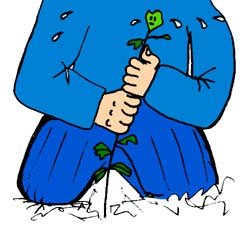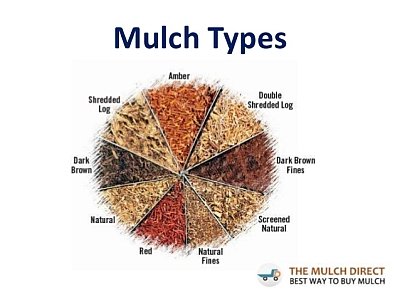Every gardener must deal with them in one fashion or another during the growing season.
Weeds are a bane of the gardener's existence until a method is devised and settled upon that suits the specific garden. The methods for controlling weeds are varied and depend upon the individual conditions and layout of the garden and type of weeds, but there are some primary means that can work in almost any garden.
Pulling
Cultivating
Mulch/Groundcover
Spraying
Don't pull your hair out, pull the weeds out!

Manual pulling of weeds is one of the most effective means of removing them, yet it is one of the most back breaking and tedious jobs in the garden. For as long as humanity has utilized agricultural practices, we have devised many means to pull weeds. The most basic of which is to use your hands to grasp the base of the plant near the soil level and pull perpendicular to the ground, or straight up. Preferably maintaining proper standing lifting posture so as not to strain the back, unless one is kneeling.


Now that technology has advanced there are items on the market designed for pulling weeds while standing such as the Fiskars Deluxe Stand-up Weeder. Reports vary on the durability of the product, so due diligence is recommended when looking to spend money on a tool.

Better known as rototilling, but a tiller is not the only tool that can be used.

Cultivation refers to the act of loosening or turning the soil. By doing so the root systems of weeds and plants are broken which can lead to them dying. With rototilling, the soil is broken and blended which integrates the weeds into the soil to be broken down by bacteria and various bugs into nutrients the vegetable plants can use. Rototilling is the primary mechanical means of cultivating, but by far not the only.
Over the years there have been numerous forms of cultivating hand tools developed.
The tine cultivator and the garden hoe were two of the original cultivators in use for millennia. More recently the stirrup hoe was invented to address some of the perceived problems with the standard hoe. The primary concerns are the potential damage to the crops and ensuring the weeds are fully removed without spreading more of the weed's seeds. Though these tend to be remedied by learning a proper technique for using the desired tool.
Generally the safest and most effective means of weed control
Mulch is a term used to describe any number of various materials used to cover the ground.
Stone, bark, rubber, compost, plastic sheeting, organic materials of most any kind, and even old carpet and cardboard can be used. The desired material is layered over the top of the soil, weighted or pinned down if plastics or sheeting, spread to desired area if any of the other materials. Many times if using rock, a woven weed barrier fabric is laid down directly on the soil with the stone over that.
The function of mulch works by blocking the sun, air, and water in some cases from reaching the weed seeds contained in the soil. Different types of mulch have different effects upon the soil conditions of moisture content, temperature, and nutrient levels. Composts can be especially useful since the high temps of the composting process kill the weed seeds, and the compost adds large amounts of nutrients to the soil.

Our farm uses black plastic mulch for weed control. The plastic we purchase is 4 mil, 20x100ft, black. This is our choice due to the ease of care and re-usability. For $65 we get 2000 sqft of plastic which is able to be used for a minimum of 3 years. By only having a 6 to 8 inch hole cut for the plants to grow through we have reduced the weeding time to one day every 2 weeks. NOTE: Drip irrigation is required if using plastic sheeting.

If you must spray, do so carefully and wear PPE!

Of all the methods of weed control, this is one of the most argued about, both for and against. Industrial level farming necessitates the use of sprays, pre-emergants, and pre-harvest due in large part to the mono-cropping. It is a function of the scale of the industrial farms. This is generally not necessary for gardeners or small scale farmers.
Sprays are notorious for having unintended consequences due to the inability to completely control the drift of the spray. No where is this more apparent than watching a crop dusting airplane fly over fields and lay down a swath of spray. Our farm uses only OMRI listed items IF we use them at all and only spray in mornings or evenings when there is no wind.*1
As a farm that practices organic methods I can not in good conscience advocate the usage of chemical sprays for weed control. If you are in need of information regarding chemical sprays the best place to look is the manufacturers websites.
Footnotes
- The only chemical used on our farm is Neem Oil mixed with water. Neem oil is extracted from the Neem Trees that are indigenous to India.
Follow the Gardener Gripe series at the tag
#gardenergripe
Prior Gardener Gripe Series Posts
Gardener Gripe #1.0 - Back Pain
Fleming Family Farm
FLEMING FAMILY FARM, LLC
Sustainable & Organic Methods | Heirloom Produce

Thought you were talking about dank kushes :(
Downvoting a post can decrease pending rewards and make it less visible. Common reasons:
Submit
Congratulations! This post has been upvoted from the communal account, @minnowsupport, by flemingfarm from the Minnow Support Project. It's a witness project run by aggroed, ausbitbank, teamsteem, theprophet0, and someguy123. The goal is to help Steemit grow by supporting Minnows and creating a social network. Please find us in the Peace, Abundance, and Liberty Network (PALnet) Discord Channel. It's a completely public and open space to all members of the Steemit community who voluntarily choose to be there.
If you like what we're doing please upvote this comment so we can continue to build the community account that's supporting all members.
Downvoting a post can decrease pending rewards and make it less visible. Common reasons:
Submit
I like a good sharp stirrup hoe! It's fast and cuts weeds off right under the soil. It works for open ground, not so much for mulched areas. In my region, mulch has pros and cons. So I use it for some crops, but not others. But I'll always like a stirrup hoe!
Downvoting a post can decrease pending rewards and make it less visible. Common reasons:
Submit